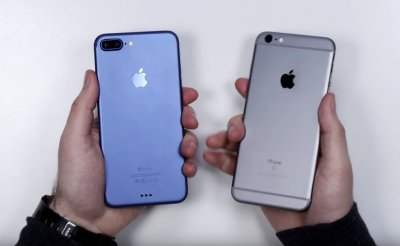Hands on with the iPhone 7: A brief peek at the wireless future

Tags: California
Hands on with the iPhone 7: A brief peek at the wireless future published by nherting
Writer Rating: 0
Posted on 2016-09-08
Writer Description: current events
This writer has written 195 articles.
The rumors got a lot right about the iPhone 7 and 7 Plus. Its design isn't too far off from the 6S and 6S Plus, it has an immovable Home button, the Plus has a dual-camera setup to simulate optical zoom, and (crucially) that headphone jack is gone.
But aside from that sticking point, the new iPhones offer a lot of the solid technological improvements that we've come to expect. The battery life is a little better. The camera is a little better. It's faster by a significant margin. We were able to take a look at some of these things in our brief hands-on time with the phone today. Some details will have to wait for the full review, but until then, here's everything you can find out about the phone after holding it for 15 or 20 minutes.
Key comparisons to the iPhone 6S
Apple didn’t talk about things like screen size and resolution or measurements and weight onstage today and I’ve received a lot of questions about it, so let’s lay those facts out up front.
The iPhone 7 and 7 Plus have the same 4.7 and 5.5 inch screen sizes as the 6 and 6S series, and the resolution and density of both screens is the same. The 7 has a 326 PPI 1334×750 screen, and the 7 Plus has a 401 PPI 1080p display. Android phone makers have surpassed these resolutions and densities at this point, but those improvements are mostly academic and reduce battery life (super high-res screens are useful for VR, though that’s still a tiny niche in the wider consumer market). Higher brightness and support for the wider DCI-P3 color gamut are the main display improvements, but superficially they’ll look mostly like the 6 and 6S screens.
The 7 and 7 Plus are also identical to the 6S and 6S Plus in height, width, and thickness. The 7 and 7 Plus are a bit lighter, though, despite the continued use of 7000-series aluminum: the 7 is 4.87 ounces/138g (down from 5.04 ounces/143g) and the 7 Plus is 6.63 ounces/188g (down from 6.77 ounces/192g). The 6S and 6S Plus were actually subtly but noticeably heavier than the 6 and 6 Plus they replaced, so the weight reduction is welcome news.
Wireless specs remain mostly the same: 867Mbps 802.11ac with Bluetooth 4.2. The 450Mbps LTE, up from 300Mbps, is the main difference there. And the iPhone 7 has optical image stabilization in its 12MP camera, something that was previously confined to the larger iPhone 6 Plus and 6S Plus.
Apple’s product comparison page is a great place to look if you just want to see how all the numbers stack up, and our post on the announcement has other key facts about the camera and other improvements.
Design
If you buy the silver, gold, or rose gold finishes, the iPhone 7 looks a lot like the 6S—it’s no accident that Apple focused mainly on the much different-looking glossy Jet Black finish in its presentation. The giveaways are the missing headphone jack, the larger camera lens and bump, and the streamlined antenna cutouts—the latter is still more noticeable on the lighter finishes because Apple doesn’t try to match the color of the aluminum as it does with the black and jet black finishes.
Coming from the 6S, I noticed the reduction in weight as I held and played with both phones. It’s not a night-and-day difference, but you’ll feel it in your hand and in your pocket. Otherwise, the screen bezels are the same size and touching the screen and using the camera is going to feel pretty familiar to 6 and 6S users.
The black and jet black finishes are nice—I never minded “space grey,” really, but Apple never did settle on one consistent shade that it used across all of its products or even different generations of the same product. The black color, which most closely resembles the black finish on the iPhone 5, should hopefully be easier to make consistent.
The jet black finish is the most striking and visually distinctive of the four. The curved edges and curved glass of the 6, 6S, and 7 were always meant to seem as though they blended together, but the jet black finish actually accomplishes that visually. I didn’t feel like the phone was going to slip out of my hands (at least, not any more than I normally do with the slippery-ish iPhone 6-era design), but just like the front of the screen that glossy black is going to be a fingerprint magnet. Apple employees were constantly wiping the front and back of the display phones to keep them looking pristine for press pictures, but that’s not how a real one will look for long.
Taptic TouchID
The solid Home button was actually the most jarring change about using the iPhone 7.
Apple’s Taptic Engine does provide feedback when you touch the button, but it’s now much more like the haptic feedback you’d get from a capacitive or software button on an Android phone. The Force Touch trackpad feels pretty close to a regular trackpad because the haptic feedback is localized, creating the illusion that just the trackpad is moving.
The iPhone 7’s Taptic Engine is less precise, so the entire phone vibrates slightly as you press down on the Home button. You can adjust the force of that feedback in the settings (and an Apple representative said it would be added to iOS’ increasingly lengthy first-time setup process, too), but it still feels like pushing a solid thing that makes the phone vibrate instead of pressing a button. It will also take some time to get used to the amount of force needed to register as a “click,” something that was far more obvious with the old clicky button.
My gut reaction is that I don't quite like the taptic Home button as much as the physical one—the simulated version of the button feedback isn’t as satisfying as the actual physical version. But like the Force Touch trackpad, I expect it’s a good enough simulation of the real thing that you’ll get used to it and then forget about it.
AirPods
Apple’s wireless AirPods aren’t going to make everyone happy, but I can at least say that Apple seems to be delivering on the promises it made about ease-of-use and sound quality.
Apple was constantly cycling out new pairs of AirPods to give to journalists in the demo room so that people wouldn’t need to stick things in their ears that had just been stuck in someone else’s ears. This meant pairing many different sets to the limited number of demo phones multiple times, and it only took a couple of seconds for the iPhone 7 to see a new pair of AirPods once they were nearby. Battery indicators for the pods themselves and the charging case are available in software.
The AirPods also did all of the stuff that Apple said they would despite the crowded room. Pulling one out while music was playing paused the music, and double-tapping one of them turned on Siri. And even though the room was jam packed with thirsty journalists trying to capture pictures and videos of the new hardware, the beam-forming mics captured everything I said without any apparent trouble.
The problem is that AirPods are shaped like all other Apple earbuds and not everyone cares for Apple’s earbuds. For some, that’s a preference (I like them fine, many in the Ars Slack don’t). For others, like my wife, the buds physically won’t stay in her ears. There are already Beats headphones with some of the same basic features available; hopefully Apple’s W1 wireless chip will become generally available for other accessory makers to use, too.
A quick note on the W1: it’s used to make pairing and battery status checking and the Siri features work quickly and seamlessly, but the actual audio is still being streamed over good-old Bluetooth, and the AirPods can be paired the standard way with anything that will do Bluetooth audio. So even if you do buy W1-equipped headphones to give yourself a better Apple experience, they’ll still be broadly compatible with other devices.
The case of the disappearing headphone jack
The AirPods are entwined with the other iPhone 7 issue that’s made it into most coverage about the phone: the missing headphone jack.
I’ll say that, as long as you accept as a given that Apple was going to make the headphone jack disappear, it handled the PR end of things well. On paper, it seems like Apple has done its best to give people some new stuff in exchange for the headphone jack, particularly water resistance and extra battery life. Removing the jack and using it to make the phone thinner, as some had feared, would have been frivolous. To its credit, Apple used the removal of the jack to address real problems that real people have.
Also to its credit, Apple is providing both a replacement set of headphones and the expected dongle in the box with the iPhone 7, defusing criticism that it was killing he jack purely to nickel-and-dime its customers with dongles. That doesn’t cover the cost of dongles that inevitably disappear or break, and the smaller 3.5mm dongle will be easier to lose than things like USB port and display adapters. But it wasn’t as bad as people worried it would be.
But the real-world implications will only become clear after some actual use. Will the iPhone 7 work OK with the weird aux jack setup in my car? Will the extra battery life make it so that I never need to walk around with headphones and an external battery plugged into my phone at the same time? Will accessory makers be able to skirt the issue in creative ways, adding headphone jacks to cases or creating dongles that allow simultaneous listening and charging?
Will the iPhone 7 be successful enough to push everyone in consumer electronics—not just other phone makers, but everyone who makes headphones and things that headphones plug into—to embrace the promised wireless future instead of defaulting to the 3.5mm jack? Apple is probably the only company on earth that is big enough and influential enough to force the issue and it has navigated these technological transitions successfully in the past, but that doesn’t guarantee success. And if Apple does succeed, how long will it take the 3.5mm jack to fade away? You can still run into older 30-pin accessories in hotels and cars of a certain age; will we still be searching for dongles a decade from now?
I have lots of questions in this vein and they’re not questions I can answer after 15 minutes of hands-on time. It will take weeks and months and years of real-world usage to find all the points of friction and address them. I do think that Apple has added enough new stuff to the iPhone 7 to make it worth considering despite the headphone thing, something I wasn’t sure about based on the rumors we were seeing before. But it’s still going to define the phone in a lot of ways, and we’ll need to wait for sales figures and the response of third-party accessory makers to tell us which way the winds are blowing.
Our full review will be posted later this month—we’ll have more on performance, the camera, and the audio and headphone jack issues then.
Sources: No sources found for this article.
You have the right to stay anonymous in your comments, share at your own discretion.


